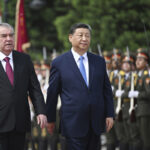When it’s all said and done, South America can look back at its overarching performance in the 2023 Rugby World Cup with pride.
Argentina, long the juggernaut nation on the continent, is doing its thing and in the hunt to get to the knockout stages out of Pool D as of this writing Friday evening. Plucky Uruguay won a pool game (against Namibia) and additionally gave hosts France a surprise 27-12 dogfight in Lille. And then there’s Chile, which went from being fully amateur just a few years ago to playing the likes of England, Japan and none other than Los Pumas in a World Cup in its first-ever appearance.
The continent can admire how far it has come. However, the question that’ll follow them once they return from France is what’s next.
A growing rugby region, South America will be the only mass-inhabited continent to have never hosted a Rugby World Cup once the United States does in 2031, despite the fact that Argentina has made multiple World Cup semifinals and only Europe and Oceania brought more countries to play in the current World Cup. That fact, along with the matter that South America is making waves in its regional club and international scenes to try and help put itself on the map, makes it worth wondering if it’s only a matter of time before South America truly emerges as a force to be reckoned with in the rugby world.
South America loves a bit of rugby. How it can unite together in that regard may be the key to how the continent takes the next step forward.
Here’s a look at some of what South American rugby can do to expand its footprint on the worldwide rugby sphere even further following one of the best-ever periods for the sport in the region:
Follow Chile’s Lead
It was a long road toward Chile being the first World Cup debutant since Russia in 2011, with the Condores going from being annihilated in a record 89-6 defeat at the hands of continental compatriots Argentina in 2009 to playing Los Pumas 14 years later in a World Cup.
Until Super Rugby Americas side Selknam, based in the capital of Santiago, was founded in 2019, the national team — despite being either mostly or fully amateur — was one of the better squads in South America, yet still wasn’t able to quite take the next leap toward qualifying for a World Cup.
Then, some groundbreaking moments occurred.
Chilean exports to foreign leagues have been fairly rare anyway, but national team captain and flanker Martin Sigren completely broke the mould for what a rugby player from his country could achieve when he signed a year-long deal in the summer of 2022 to play with the Doncaster Knights of the RFU Championship, being the first Chilean rugby player to play for a professional English side.
Meanwhile, back home, Selknam was thriving in the then-Superliga Americana de Rugby (Super Rugby Americas’ precursor competition), making the SLAR final in 2022 with a squad that’s almost a carbon copy of the national team fans have seen at the World Cup. All that positivity looped in with upset eliminations in World Cup qualifying against Canada and the United States, helped boost the Condores to France, where they’re now having the time of their lives as they wear their country on their sleeve.
The moral of the story? Chile built the infrastructure to help it modernize its rugby scene and had players that clubs in stronger leagues were willing to take a chance on. Another nation trying to beef up its rugby scene in South America could do the same sometime soon.
Get Brazil More Involved
First, let’s make one thing clear: football is king in Brazil and will probably always be. It’s the national sport and the game that the country is known the world over for, with it being a major part of its identity and culture.
But the largest country in South America and seventh-most populated nation in the world is one of Earth’s largest untapped rugby markets, and growing the game there will go a long way toward making the continent one of the world’s strongest in the rugby world.
Brazil’s men’s national rugby team, The Tupis (named after an indigenous ethnic group in Brazil), has never qualified for the World Cup, though has beaten current/former World Cup sides such as Chile, Canada and Portugal in the past, showing that the potential for the sport in the country is there.
Momentum has especially started to build following World Rugby’s investment in Brazil, partly due to the 2016 Rio Olympics when rugby sevens was added to the event schedule, while the women’s sevens team (which has qualified for all four Women’s Rugby World Cup Sevens tournaments) has already been considered by most to be South America’s best women’s sevens team for some time. And back in men’s 15s, the country has a club team in Super Rugby Americas — the Cobras — which gives Brazil a professional squad to develop players year-round.
If Chile, which has less than one-tenth of the population of Brazil and is similarly energetic about football, can get its national side to a Rugby World Cup, there’s no reason to believe that Brazil can’t sometime in the future, either — and Brazilians’ sporting passion will likely be all out in support when it happens.
Strengthen Ties With North America
South American rugby’s relationship with its northern counterparts is in a bit of a weird place.
At club level, Super Rugby Americas expanded to seven teams — and the North American continent — for the 2023 season when the league added the Colorado-based American Raptors (formerly known as the Glendale/Colorado Raptors in North America’s top domestic league, Major League Rugby) to the mix, though an additional proposed entry from Canada’s Pacific Pride (a British Columbia-based development academy squad for the Canadian national team) fell through.
Though numerous factors (namely financial and logistical) likely come into play for why the topic hasn’t gained serious steam, perhaps the growth of both Super Rugby Americas and MLR could result in a type of tournament in the future similar to the European Rugby Champions Cup — some sort of major multinational competition with high stakes and high rewards, plus extra revenue potential for the clubs and leagues involved. Both the SRA and MLR are less than a decade old, so any such idea would likely require some patience, but it could be worth exploring as each league builds up pedigree.
Meanwhile, at the international level, North and South America had their own version of the Six Nations known as the Americas Rugby Championship in stints from 2009-19 featuring the U.S., Canada, Chile, Uruguay, Brazil and Argentina’s second team, but once the 2020 version was cancelled due to COVID-19, the competition went dormant. Nothing similar has arrived to succeed it since, and though a revamped World Cup qualification system in the Americas has combined and pitted North and South teams against each other, the restart of a yearly competition of national teams could be of great benefit to getting teams out on the pitch against similar levels of competition.
Make a Joint World Cup Bid
Before anyone gets their hopes up too much, the most realistic date for a future Rugby World Cup bid in South America is likely 2039. The 2027 (Australia) and 2031 (United States) World Cup locations have already been decided on by World Rugby, while 2035 will likely see feverish bids from European nations (who will have gone two cycles without a tournament since France 2023) and/or South Africa (which hasn’t hosted since its famous home World Cup win in 1995), both of whom would be deserving picks.
But getting the groundwork started now for a 2039 hosting would by no means be a bad idea, and there are a lot of things that are in South America’s favour if it was to either see one of its countries make a solo bid or pool together to file a joint bid.
First, a clear, improving standard of rugby with the continent’s three teams made the current World Cup, which is more than Africa or Asia (both of whom have hosted World Cups in the past) can claim. Second, the continent has proven it can host major, global-scale athletics events in the past: South America’s country with the best rugby framework in Argentina, which withdrew bids for both the 2023 and 2027 World Cups, hosted the 1978 FIFA World Cup and was recently confirmed to be (along with Uruguay and Paraguay) hosting the opening matches of the 2030 FIFA World Cup to celebrate the tournament’s 100th anniversary.
Those games could indirectly act as a test run for World Rugby to observe as it mulls 2039 bids, and with stadium infrastructure in place already all across the continent from football — such as the massive Estadio Monumental in Buenos Aires, which holds over 86,000 fans — the appeal is there for World Rugby.
The lingering question of if Argentina would try and go it alone again on a bid or team up with the likes of Uruguay, Chile and/or Brazil or others has an unknown answer at the moment, but as the largest corner of the world to have not hosted (or be slated to host) a Rugby World Cup, it feels like it’s time. South America just needs to throw its name in World Rugby’s hat first to give itself a chance.
Source : Florugby
















